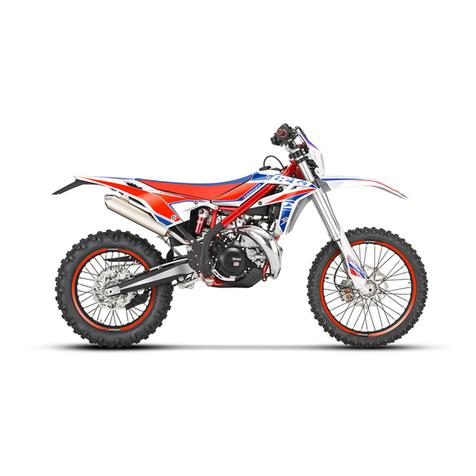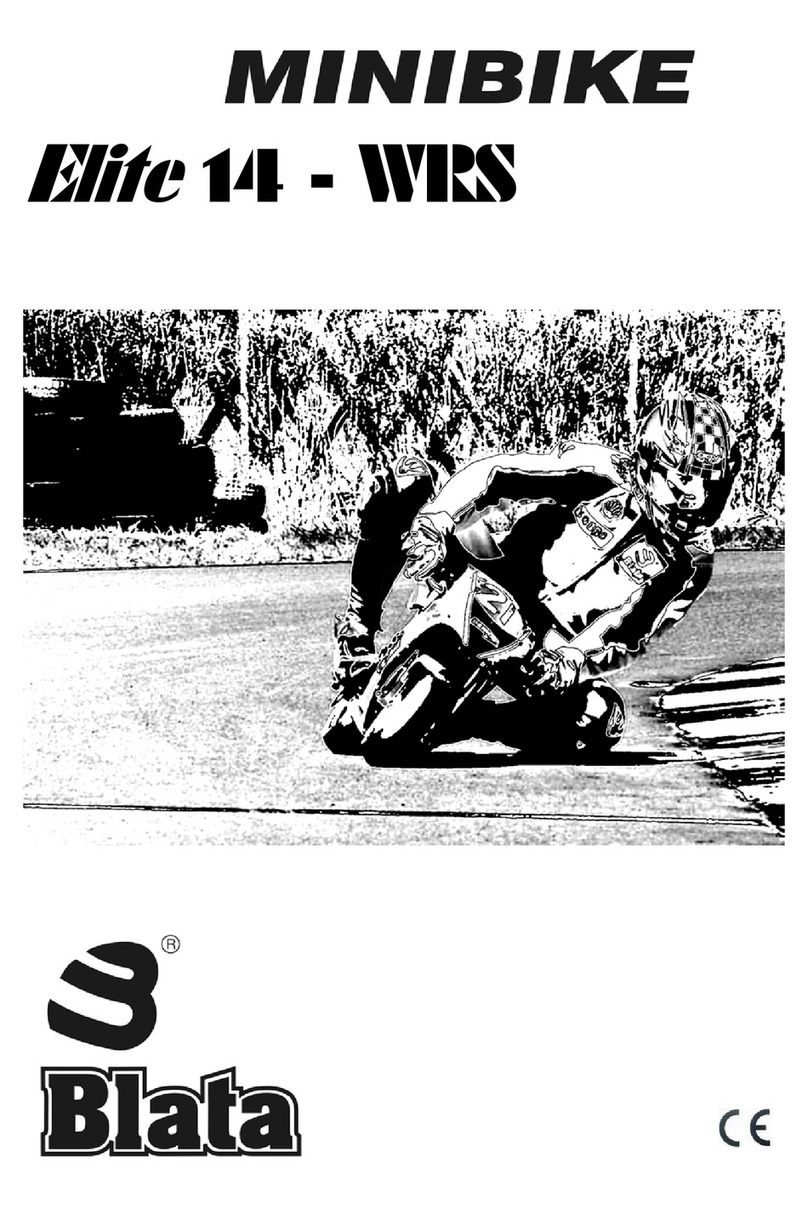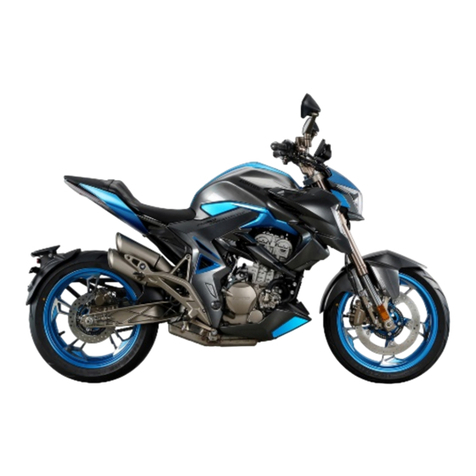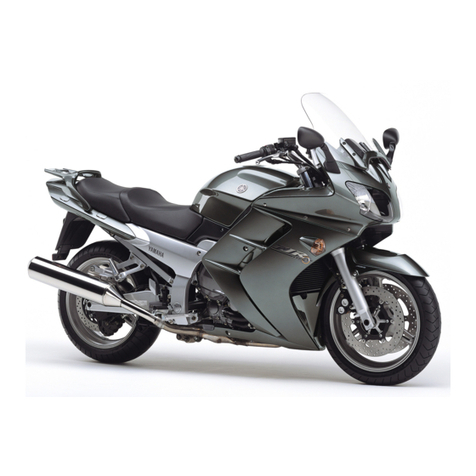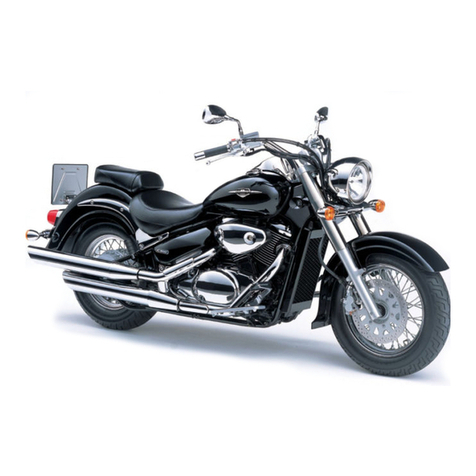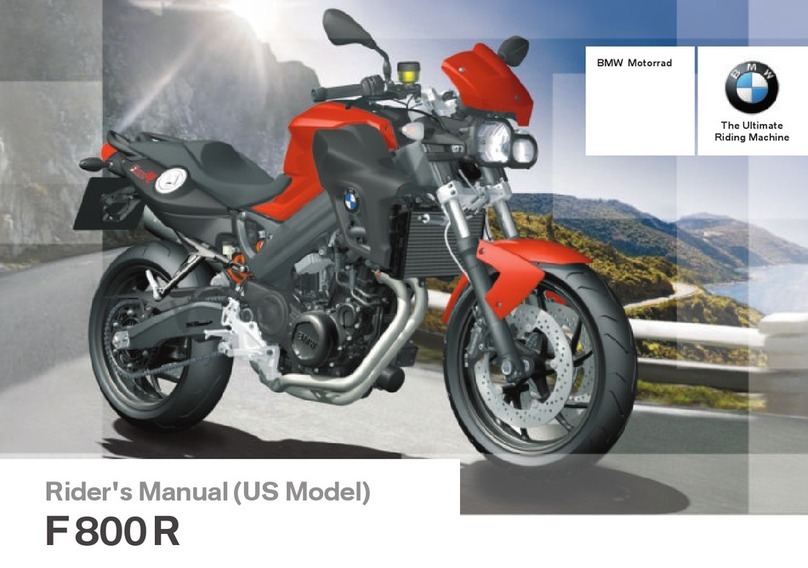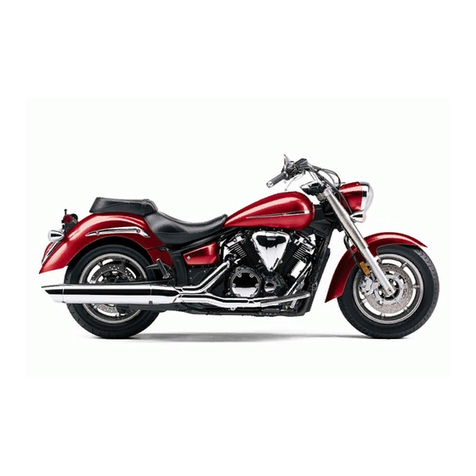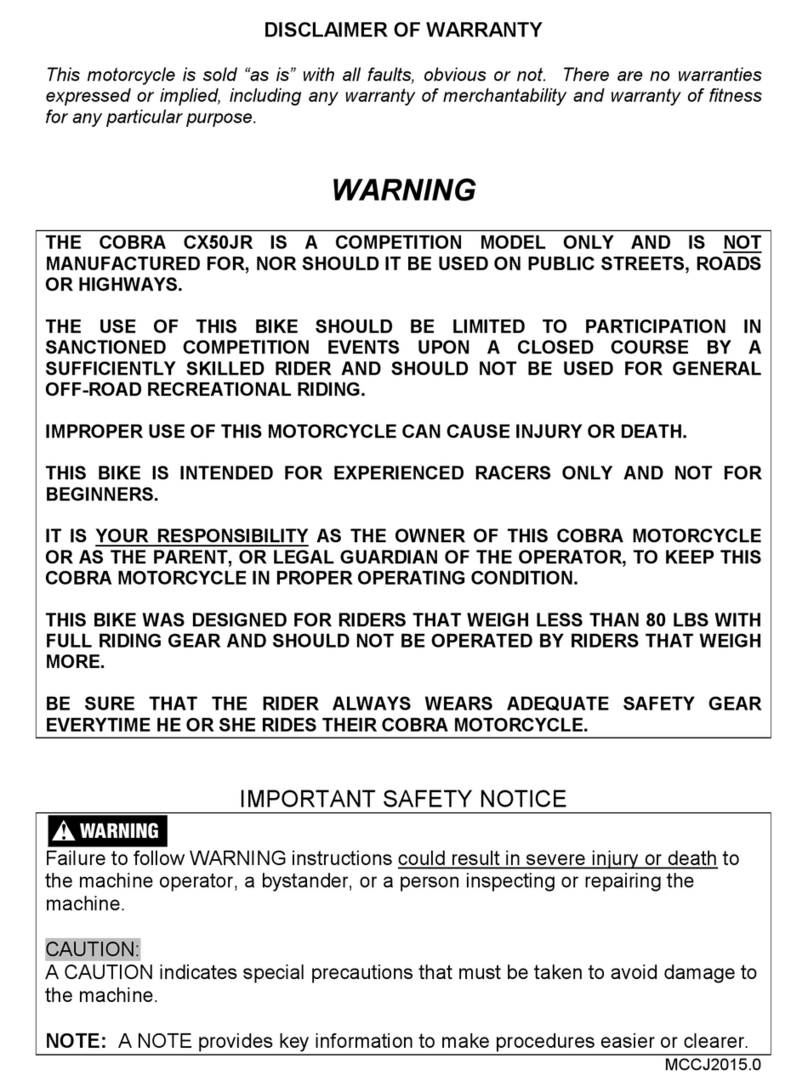EBOX 1.6 User manual

OWNER’S MANUAL
Please read and understand this manual fully before use.
Note: The manual illustrations are for demonstration purposes only.
Illustrations may not reect the exact appearance of the product.
Specication subject to change without notice.
OFF ROAD USE ONLY
DO NOT OPERATE THIS VEHICLE IF
YOU ARE UNDER THE AGE OF 13

INTRODUCTION
Thank you for purchasing an EBOX.
The proper care and maintenance that your vehicle requires is outlined in
this manual. Following these instructions will ensure the long and
trouble-free operating life of your bike.
This owner’s manual corresponds to the latest version of this vehicle at
the time of printing. Slight deviations resulting from continuing
development and design cannot be completely excluded. All
specications are non-binding and we reserve the right to modify or
delete technical specication, parts, design, etc without prior notice.
SAFETY WARNINGS
This vehicle is NOT A TOY and should ONLY be used o road and away
from public roads.
Never let children under the age of 13 operate this vehicle.
Adult supervision is required if children are under the age of 16.
WARNING:
Riding the EBOX can be a hazardous activity. Certain conditions may
cause the equipment to fail without fault of the manufacturer. Like other
vehicles, the EBOX can, and is, intended to move. It is therefore
possible to lose control, fall and/or get into dangerous situations that no
amount of care, instruction or expertise can eliminate. If this situation
occurs you can be seriously injured or die, even when using safety
equipment and other precautions.
RIDE AT YOUR OWN RISK AND USE COMMON SENSE.
This manual contains many warnings and cautions concerning the
consequences of failing to maintain, inspect or properly use your EBOX.
Any incident can result in serious injury or even death, therefore we do
not repeat the warning of possible serious injury or death each time such
a possibility is mentioned.
APPROPRIATE RIDER USE AND PARENTAL SUPERVISION
This manual contains important safety information and use tips to help
you and your child operate and handle the EBOX. Carefully read the
manual in its entirety together with your child before letting them ride for
the rst time. The manual also contains important information on
servicing the vehicle.
It is your responsibility to review this manual and make sure that all riders
understand the warnings, cautions, instructions and safety topics. Also
please ensure that the riders are able to safely and responsibly use this
product and protect your child from injury. We recommend that you
periodically review and reinforce the information in this manual with the
rider and that you inspect and maintain the vehicle to ensure its safety.
The recommended rider age of 13 is only an estimate and can be
eected by the rider’s size, weight or skills. Any rider unable to t
comfortably on this vehicle should not attempt to ride it.
It is important and necessary to conduct the relevant technical training
with your child before rst use. To obtain the training information, please
contact the dealer who you purchased the vehicle from. Do not let your
child use this vehicle before they have completed this training.

Children often underestimate or fail to recognize dangerous situations.
You should make it clear to your child that they should not, under any
circumstances, operate the vehicle without supervision and that your
child may only drive at speeds that are suited with the child’s riding
ability and other terrain conditions.
A parent’s decision to allow his or her child to ride this vehicle should be
based on the child’s maturity, skill and ability to follow rules.
Keep this product away from small children, younger than 13 and
remember that this product is intended for use only by people who are at
a minimum, completely comfortable and competent while operating the
vehicle.
Do not exceed 85kgs (187lbs) total weight on this vehicle. The rider
weight does not necessarily mean a person’s size is appropriate to t or
maintain control of this vehicle.
Do not touch the brakes or motor on your bike when in use as they can
become very hot.
The rider and/ or parent assumes all risk associated with riding activities.
Maintain grip of the handlebars at all times.
Never carry passengers or allow more than one person at a time to ride
the vehicle.
Never use near steps or swimming pools.
Keep your ngers and other body parts away from the drive chain,
steering system, wheels and all other moving components.
Never use headphones or a mobile phone when riding.
Never hitch a ride with another vehicle.
Do not ride the vehicle in wet or icy weather and never immerse the
vehicle in water, as the electrical and drive components could be
damaged or create other unsafe conditions.
The vehicle is intended for use on at level ground without loose debris
such as rocks or gravel. Wet, slick, bumpy, uneven or rough surfaces
may impair traction and contribute to accidents. Do not ride the vehicle
in mud, ice, puddles or water. Avoid excessive speed that can be
associated with downhill rides.
Never risk damaging surfaces such as a carpet or ooring by using the
vehicle indoors.
Do not ride at night or when visibility is limited.
ACCEPTABLE RIDING PRACTICES AND CONDITIONS
Always check and obey any local laws or regulations which may aect
the locations where you intend to use the vehicle.
Ride defensively. Watch out for potential hazards that could catch your
heel or force you to swerve suddenly or lose control.
Be careful to avoid pedestrians, skaters, skateboards, scooters, bikes,
children or animals who may enter your path, and respect the rights and
property of others.
The EBOX is meant to only be used in controlled environments free of
potential trac hazards and not on public streets or roads. Do not ride
your vehicle in any areas where pedestrians or trac are present.
Do not activate the throttle unless you are on the vehicle and in a safe,
outdoor environment suitable for riding.
The EBOX was manufactured for performance and durability but is not
impervious to damage. Jumping or other aggressive riding can
stress and damage any product, including this vehicle and the rider
assumes all risks associated with high-stress activities. Be careful and
know your limitations. Risk of injury increases as the degree of riding
diculty increases.

PROPER RIDING ATTIRE
Always wear appropriate safety equipment such as an approved
safety helmet, elbow and knee pads. A helmet may be legally required by
local law or regulation in your area. A long-sleeved shirt, long pants and
gloves are recommended. Always wear motorcycle boots, never ride
barefooted or in sandals,
USING THE CHARGER
The charger supplied with the vehicle should be regularly examined for
damage to the cord, plug, enclosure and other parts. In the event of
such damage, the bike must not be charged until the charger has been
repaired or replaced.
Use only with the recommended charger. e.g.
• 48V lithium battery charger with label: 54.6V
• 60V lithium battery charger with label: 67.2V
Use caution when charging.
The charger is not a toy and should be operated by an adult.
Do not use the charger near ammable materials.
Unplug the charger and disconnect from the bike when not in use.
Always disconnect the charger prior to wiping down and cleaning the
vehicle with liquid.
FAILURE TO USE COMMON SENSE AND HEED THE ABOVE
WARNINGS INCREASES RISK OF SERIOUS INJURY. USE WITH
APPROPRIATE CAUTION AND SERIOUS ATTENTION TO SAFE
OPERATION.
LOCATION OF WARNING STICKER
VIN Location
The VIN is stamped on an aluminium plate
that is riveted to the steering column.
VIN means the Vehicle Identify Number
which is unique for each EBOX.
Hand Drive Controls
1. Front brake lever
2. Rear brake lever
3. Key switch
4. Battery indicator
5. Safety ON/OFF switch
6. Throttle
ATTENTION: BATTERY STATE!
STOP USE and charge the battery once the indicator shows 10%

BEFORE YOU BEGIN
Open the box and inspect the contents
for any scratches, dents or cable kinks
that may have occurred during shipping.
Your EBOX was 85 percent assembled
and packed at the factory, so there
should not be any problems, even if your
box has a few scratches or dents from
shipping.
However, if you do nd an issue, please
report it immediately via our contact
form which can be reached here:
Http://www.stomp-group.com
Remove the bike and place on a suitable assembly stand, ensuring the
bike is secure and will not tip over.
Remove all protective packaging taking care not to cut any cables or
components if using a sharp blade. DO NOT remove the graphics’
protective lm until the bike is fully assembled to avoid any accidental
damage. DO NOT cut the zip ties that group the control cables together.
Remove all loose items such as the front wheel, number board, front
mud guard and accessory box.
Check that all components are present and nothing appears to have
been damaged or missing from transit.
Place these items in a safe place to avoid any accidental damage.
Discard all packaging along with the cardboard box via the appropriate
recycling stations.
You are now ready to begin assembling your bike.
MAKE SURE THE KEY SWITCH IS TURNED “OFF”.
Estimated Assembly and Set-Up Time
We recommend assembly by an adult with experience in motorbike
mechanics.
• Allow up to 30-40 minutes for assembly.
• Allow up to 1 hour to conduct a full PDI after assembly (PDI
instruction can be found at the back of this manual).
• Allow up to 7-9 hours for initial charge depending on the model.

1. Rear shock
2. Crossbar pad
3. Assembly bolts, fuse, handle bar clamps
4. Crossbar pad graphics
5. Tool kit
6. Charger lead
7. Charger
The list of tools required is as follows:
- Wrench or Socket
8mm / 13 mm / 14mm / 15mm / 17mm
- Allen key
5mm / 6mm
ASSEMBLY ILLUSTRATION AND INSTRUCTION
Handlebar Assembly
Caution: Failure to properly adjust and tighten the bolts that afx the
handlebars can cause you to loose control and crash.
1. Place the handlebar in
the bottom clamp, then
install the top clamp
section and 4 retaining
bolts, do not fully tighten
at this point.
Front Mud Guard
Mount the front mud guard to the fork lower stantions and secure with
the 3 provided bolts.
The mud guard has 2 sets of mounting holes, you should use the
forward most set of holes (as seen in the above photo) to secure your
mudguard to the fork stantion. Tighten the guard down securely.
Number board
Remove the allen head bolt from
the fork mounting tab. This is
located on the upper fork stantion.
Locate the lower number board
dowels into the corresponding
mounts on the front mud guard.
3. Put the moulded foam barpad
over the clamps and secure into
place with the crossbar pad
graphics. This will loop around the
pad and secure with velcro
underneath.
2. Move the handlebar to a comfortable riding position, then tighten all 4
bolts securely with an allen key, making sure to tighten in a cross
formation to ensure even clamping pressure (See diagram).
Tools Required
Tools may be supplied; however, we recommend the use of
mechanic grade tools. Use the supplied tools only as a last resort.
As well as the bike, you will nd a small box with the below parts inside.

Front Wheel
1. Undo the retaining nut and remove the
axle from the forks. Be careful not to lose
either of the wheel washers.
2. Place the wheel between the forks
ensuring that the disc is situated between
the brake calliper pads.
3. Insert the axle through the left fork
dropout.
4. Slide the longer 28mm spacer onto the
axle between the wheel (disc side) and fork
leg.
5. Continue sliding the axle through the
wheel and right fork leg, making sure to
install the second shorter (24mm) spacer.
5. Secure the axle in place using the
nut we previously removed and tighten to
47Nm.
1.Start by removing the brace that
has been tted between the 2 shock
mounts to protect your Ebox during
shipping.
Rear Shock Absorber
3. Lift the frame allowing the shock
and swingarm to pivot. Align the lower
mounting hole with the corresponding
mount point on the swing arm.
2. Install the shock into the upper shock
mounting position. There are 2 upper
shock mounting points. Mounting in
either position A or B will eect the seat
height of your Ebox.
Secure the shock in the mounting point
and tighten down to 27Nm.
Then, using the bolt we
previously removed, secure the
number board to the fork
mounting tab and tighten down
securely. Keep the control cable
behind the number board to
secure them into position.
4. Use the bolt to secure the shock to
the swing arm mount and tighten the
nut to 27Nm using a wrench.

1. Remove the front right fairing. This
will allow easy access to the fuse holder.
To do so, remove the single allen bolt
and carefully slide the plastic to the rear
of the bike to unhook the plastic from
the retaining tab, being careful not to
damage anything.
2. Locate the fuse. This is in the bag of
accessories we put to one side earlier.
3. Disconnect the battery.
4. Carefully insert the fuse into the fuse
holder.
5. Reconnect the battery power supply.
6. Replace the fuse holder into the body
of the bike.
7. Re-install the side fairing, this is the
opposite process of removal.
CAUTION: There may be residual
charge in the power system causing
the fuse to ‘pop’ on installation. To
avoid this you should disconnect the
battery when installing the fuse.
Note: The tyres are inated when shipped but they invariably lose some
pressure between the point of manufacture and your purchase. Always
inate the tyres to the correct PSI before rst use.
We recommend 26psi for use on tarmacked surfaced and anywhere
between 20-30psi for o road use depending on conditions.
Use a bicycle-style pump to inate the tyre to the PSI indicated on the
sidewall.
Note: The pressurised air pumps found at petrol stations are designed
to inate high-volume car tyres. If you decide to use such an air pump to
inate your tyres, rst make sure the pressure gauge is working, then use
very short bursts to inate to the correct PSI. If you
inadvertently over-inate the tyre, release the excess pressure
immediately.
Important information for tyre use
Note: The tyre is the only contact between the vehicle and the road, the
safety of various driving activities depends on the small area contact
patch of the tyre with the road. Therefore, it is very important to keep the
tyre in good condition at all times and use the correct size and standard
tyre to replace worn items. These are available from your EBOX dealer.
Guide:
Tyre assembly and disassembly
It is strongly recommended that the tyre assembly and disassembly is
done by an authorised technician with the necessary skills.
Tyre pressure
It is very important to keep the tyre properly inated and check tyre
pressures before use. Inating should be done while the tyre is cold.
Tyre maintenance
Tyre tread depth should be checked regularly. (Shallower tread means
Inate The Tyres
Fuse
Rear Mud Guard
1. Locate the mounting plate and 2x M6 bolts for the rear mudguard.
2. Feed the bolts through the mounting plate, mud guard and then
tighten down to the bracket that is axed to the swingarm. This will
sandwich the guard in place.

of time the battery may reach a stage at which it will no longer hold a
charge.
WARNING: Rechargeable batteries are only to be charged under adult
supervision. Always disconnect your EBOX from the charger before
cleaning.
NOTE: EBOX chargers have built-in over charge protection. Chargers will
get warm during use, this is normal for some chargers and is no cause
for concern. If your charger does not get warm during use, it does not
mean that it is not working.
The charger has a small window with an LED to indicate the charge
status. A Red LED means the battery is charging and a Green LED
means that the battery is fully charged.
Be sure to properly align the keyway on the charger input port with the
corresponding socket on the vehicle and tighten snugly; otherwise,
your vehicle may not charge.
less grip). You must stop use of the vehicle if the tyre is punctured.
If your tyre is punctured remove the tyre and check it carefully
taking care not too injure yourself as there may be sharp objects
embedded in the tyre. Tyre maintenance should be done by an
authorised technician. If the tyre becomes distorted or damaged it
should be replaced immediately.
Tyre replacement
It is important to use the correct size and standard tyre as per the
specication (see details in technical specication sheet)
Do not use part worn/ used tyres if you are not sure of its previous
service condition.
Tyre aging
Tyre aging is unavoidable. Even if the tyre has never been used or just
used a few times. Tyre aging is mainly reected in visible cracking on the
sidewall of and tyre tread itself, sometimes the tyre can become
distorted as well.
Charging the Battery
Your EBOX may not have a fully charged battery upon purchase;
therefore it is essential to charge the battery prior to use.
- Initial charge time: 7-9 hours depending on level of depletion.
- Run time: up to 45 minutes of continuous ride time at MAX speed; run
time may vary depending on riding conditions.
- Average battery life: 250-500 charge/discharge cycles depending on
which type of battery. To ensure long battery life, do not store the batter-
ies in temperature above 40℃ or below 0℃.
- Recharge time: Always remember to turn the EBOX power switch o
and recharge for at least 7-9 hours after each use depending on the
model. When the vehicle is not in regular use, recharge the battery at
least once a month until normal use is resumed. If you have left the
power switch on or your product has not been charged for a long period

Warning: Failure to recharge the battery at least once a month may
result in a battery that will no longer hold a charge.
SAFETY REMINDERS
PRE-RIDE CHECKLIST
Loose Parts
Check and secure all fasteners before every ride. You should make sure
that the handlebar riser clamp bolts are adequately tightened. There
should be no unusual rattles or sounds from loose parts or broken
components. If you are not sure, ask an experienced mechanic to check
the bike over for you.
Brakes
Check the brakes for proper function. When you squeeze the lever, the
brake should provide positive braking action and lock up the wheel while
stationary.
Frame, Fork and Handlebars
Check for cracks or broken connections. Although broken frames are
rare, it is possible for an aggressive rider to cause damage to their frame
from a cash or hard impact. Get in the habit of inspecting yours regularly
to avoid accidents.
Tyre Ination
Periodically inspect the tyres for excess wear, regularly check the tyre
pressure and re-inate as necessary. If you get a at tyre, the inner tube
can be patched or a new tube can be purchased from an EBOX
authorised dealer.
Safety Gear
Always wear proper protective equipment such as an approved
safety helmet, elbow and knee pads. Always wear motorcycle boots,
never ride barefoot or in sandals. Keep and loose objects away from the
wheels, motor and the drive system.
Starting The Bike
Always take care when starting the bike as it is very powerful, with
adjustable motor response and speed limiter. Always check these
settings before starting the bike.
Note: Make sure the power
is turned OFF when unit is
not in use. If the
power switch is left on for
an extended period of time,
the battery may reach a
stage at which it will no
longer hold a charge.
Plug the charger into a wall
outlet. If the lights on the
charger do not light up,
check the power to the
outlet. If necessary, try a
dierent outlet.
Turn the power OFF before
charging. Plug the
charger into the charger port
to charge your EBOX. Then
turn the power back ON.

ATTENTION
We recommend re-checking all parts after the rst ride to ensure they are
still correctly tightened and have not come loose. We
recommend special attention be paid to the following parts:
- Foot pegs
- Motor sprockets
- Shock absorber
- Motor bolts and nuts
- Rear sprocket
- Wheels
- Chain Tension
- Brakes and Callipers
TECHNICAL SPECIFICATION SHEET
MODEL EBOX 1.6 EBOX 2.0
MOTOR 48V 1600W - BLDC motor 60V 2000W - BLDC Motor
MAX SPEED 30mph 33mph
FINAL DRIVE 10t/ 70t, chain 219H
CONTROLLER
OUTPUT
42A 45A
BATTERY 48V/ 15.6Ah lithium 60V 18.2Ah lithium
CHARGER 110-240v/ 54.6V 2A 110-240V, 67.2V 2A
CHARGE TIME 7-8hrs
RANGE PER CHARGE 17-19miles 20-23miles
FRAME High tensile steel double cradle tube frame, powder coated
SUBFRAME Removable
HANDLEBAR Aluminium Ø 22mm
FRONT SUSPENSION Upside-down forks, Φ39x Φ41, 550mm
REAR SUSPENSION Mono shock 270mm
BRAKE SYSTEM Hydraulic brake
DISC BRAKE F/R Ø 180mm
FRONT/REAR RIM 1.4 x 12”, 1.6 x 10” 1.4 x 14”, 1.85 x 12”
FRONT/REAR TYRE 2.75 x 12”, 3.0 x 10” 60/100 x 14”, 80/100 x 12”
WHEELBASE 940mm 955mm
GROUND
CLEARANCE
235mm 255mm
SEAT HEIGHT 630mm 660mm
MAX LOAD 85kg
N.W/ G.W 40.5kg/ 50kg 42.5kg/ 52kg
BIKE DIMENSIONS 1330 x 645 x 850mm 1400 x 645 x 890mm
PACKING SIZE 1220 x 380 x 640mm 1250 x 380 x 640mm
The motor controller is located within
the frame of the bike between the
battery and rear shock.
Response
This controls the throttle response of
the bike. Turn the adjustment knob
clockwise to increase and
anti-clockwise to decrease.
Attention, we recommend tuning
the response to its lowest setting
when children and new users are
riding the bike.
Speed
Turning the dial clockwise will
increase the top speed of the bike,
anti-clockwise will lower it.
Motor
controller
location

REPAIR AND MAINTENANCE
Chain Adjustment
Checking the drive chain periodically will ensure longer chain life.
Always keep it lubricated and tighten the chain correctly as follows:
Step 1
Loosen the 3 bolts used to hold
the chain cover in place. Once
undone, remove the chain cover
by sliding it around the swing
arm.
Step 2
Loosen the rear axle using a 17
and 14mm socket, you do not
need to remove it completely.
Undo the chain tensioner lock
nuts.
Step 3
Adjust the position of the rear
wheel and re-tighten the axle.
Check that your chain is
correctly tensioned, 15mm
movement up and down from
centre, then tighten your
adjuster lock nuts to the swing
arm and alloy block and torque
your axle to secure.
Make sure that your wheel is
centrally positioned within the
swing arm.
Step 4
Ret the chain cover and tighten
the bolts to secure.
Tuning Your Brake
Step 1
Brake bite point is adjustable on the
EBOX. To adjust the bite point, wind
in/out screw A. This will enable you
to ne tune how soon your pads
start to contact the brake disc.
If your brakes start to feel soft or
stop working, they may need to be
bled. This can be done by using
screw B. It is recommended that
this process is completed by a
competent mechanic who is trained
in bleeding hydraulic brake systems.
Step 2
To make sure your brake is
performing optimally you may need
to adjust your calliper position.
Loosen the 2x 5mm allen bolts that
hold the calliper to the bracket. Pull
the brake lever, this will centre the
brake to the disc.
Re-tighten the calliper bolts, while
keeping the lever depressed. Check
that the wheel spins freely with no
interference of pad and disc. If there
is interference repeat the process.

Pad Wear
You should regularly check the condition of your
brake pads and inspect for excessive wear. The
thickness of the braking material on the lead and
trailing edge of the four pads should never be
less than 1mm. Should the material be thinner,
immediately replace the brake pads.
We recommend having the brake pads replaced by an authorised dealer.
Warning:
The brake is capable of causing the bike to lock the rear wheel and
skid, potentially throwing an unsuspecting rider. Practice in an open
area free from obstacles until you are familiar with the brake
performance. Avoid skidding to stop as this can cause you to loose
control or damage the rear tyre.
Testing the Brakes
To use the brake, squeeze the lever to increase the pressure on the
brake. If your brake is not engaging properly, follow instructions for
adjusting the brakes.
Chain and Sprocket
The chain will typically have a “loose spot” and “tight spot”
corresponding with a particular sprocket rotational position. This is
normal and common to all chain-driven products due to run-out
tolerance of the free wheel and sprocket. It is possible to minimise these
loose/ tight spots in the chain by centering the rear sprocket to the hub.
This can be done by loosening the sprocket bolts, spinning the wheel
a number of rotations then correctly re-torquing the bolts. The chain
should then be adjusted to the ideal tension with the chain in the
tightest spot.
Proper chain alignment must be maintained. The wheel must not be
skewed, if the chain is noisy or rough running, check the lubrication,
tension and alignment of sprockets, in that order.
Warning:
To avoid a pinch or injury, keep ngers away from moving sprockets
and chain.
Problem Possible cause Solution
Vehicle
does not
run
Undercharged
battery
Charge the battery. A new battery should
have been charged for at least 7-9 hours
before using the vehicle for the rst time
depending on the model, and up to 8 hours
after each subsequent use.
Check all connectors. Make sure the charger
connector is tightly plugged into the charging
port, and that the charger is plugged into the
wall.
Make sure power ow to wall outlet is on.
Charger is not
working
Check to see if your charger is working by
using a volt meter or asking the authorised
service centre to test your charger for you.
Fuse Check the fuse has not burnt out and replace
as necessary.
Vehicle was
running but
suddenly
stopped
Loose wires or
connectors
Check all wires and connectors to make sure
they are tight.
Burnt Fuse The fuse will burn out and automatically shut
o the power if the motor is overloaded.
An excessive overload could cause the
motor to overheat. Refer to replacing the fuse
section of this manual. Correct the conditions
that caused the fuse to burn out and avoid
repeatedly burning out fuse.
Motor or
electrical switch
damage.
Contact your authorised service centre for
diagnosis and repair.
Speed
controller
damaged
Contact your authorised service centre for
diagnosis and repair.
Trouble shooting guide
1mm

Short run time
less than 15
minutes per
charge
Under-
charged
battery
Charge the battery. A new battery should
have been charged for at least 7-9 hours
before using the vehicle for the rst time
depending on the models, and up to 8 hours
after each subsequent use.
Check all wires and connectors. Make sure
the battery connector is tightly plugged into
the charger connector, and that the charger is
plugged into the wall.
Make sure the wall outlet is turned on.
Battery is old
and will not
accept full
charge.
Even with proper care, a rechargeable battery
does not last forever. Average battery life is 1
to 2 years depending on vehicle use and
conditions. Replace only with a genuine
EBOX replacement battery.
Brakes are
not adjusted
properly
Refer to brake adjustment instructions.
Faulty battey
charger
Check the charger is outputting the correct
voltage. If it is not, contact your dealer to
source a replacement.
Vehicle runs
Sluggishly
Tyres are
not properly
Inated.
The tyres are inated when shipped, but they
invariably will lose some pressure Between
the point of manufacturing and your
purchase. Refer to tyre instructions to
properly inate tyres.
Vehicle is
overloaded.
Make sure you do not overload the vehicle by
allowing more than one rider at one time,
exceeding the maximum weight limit, going
up too steep a hill or towing objects behind
the vehicle. If the vehicle is overheated, the
temperature circuit protector will slow the
motor down and if the condition continues,
will shut o power to the motor. Correct the
driving conditions that caused the
overheating, wait 5-10 minutes and then
resume riding. Avoid repeatedly overheating
the unit.
Sometimes
the vehicle
doesn’t run,
but other
times it
does.
Loose wires or
connectors
Check all wires around the motors and all
connectors to make sure they are tight.
Motor or
electrical
switch
damage.
Contact the authorized service centre for
diagnosis and repair.
Charger
gets warm
during use
Normal
response to
charger use
No action required. This is normal for some
chargers and is no cause for concern. If your
charger dose not get warm during use, it does
not mean that it is not working properly.
Vehicle
does not
stop when
applying the
brake.
Brakes are
not adjusted
properly
Refer to the brake adjustment instructions in
this manual to properly adjust brakes.
Vehicle
makes loud
noises or
grinding
sounds
Chain is too
dry
Apply a lubricant to the chain.
Worn chain /
Sprocket
Replace/ change the worn item. We
reccomend that this is done by an authorised
dealer.
Misaligned rear
wheel
Check the alignment of your rear wheel. If it
is out of line then re-centre using the guide
found earlier in this manual.
Brake pads
worn
Measure the matierial left on your pad. If it is
less than 1mm on the lead or trailing edge of
the pad then please replace them.
Wheel bearing
failed
If your wheel has side to side play then it is
likely that the rear wheel bearings have failed.
These can be changed by your local
authorised dealer.
Motor bearings
failed
If there is movement in the motor’s drive shaft
then the motor bearings may have failed.
Please get in contact with your local
authorised dealer who will be able to source
replacement parts.

EBOX PDI
Please ensure you complete a full PDI of your EBOX after initial assembly
to thoroughly check the safety of all components.
1. Starting at the rear of the bike, work your way to the front on both
sides checking that all nuts, bolts and screws are tight. Don’t assume
that because it is new from the factory that everything will be tight.
A drop of thread compound (non-permanent type) is advised on the
threads of the brake calliper bolts, front sprocket drive bolt and motor
mounting bolts.
Check the following points on your EBOX to ensure that they are tight.
(This is not an extensive list and there may be others).
• Rear wheel axle nut
• Rear wheel spokes
• Chain adjuster lock nut
• Rear shock bolt and nut at the top and bottom of the shock
• Swing arm pivot bolt/ nut
• Rear brake caliper bolts
• Rear brake disc bolts
• Rear sprocket bolts
• Chainguard bolts and chain roller bolt
• Rear subframe bolts (where applicable)
• Motor mounting bolts/ nuts
• Front drive sprocket bolt
• Footrest bracket bolts (where applicable)
• Rear brake pedal bolt
• Side stand bolt/ nut
• Handlebar bolts
• Tighten head set bearing making sure to eliminate all freeplay
• Front fork pinch bolts
• Front mudguard bolts
• Steering head bolt
• Front wheel axle nut
• Front wheel spokes
• Front wheel axle clamp bolts (where tted)
• Front brake caliper bolts
• Front brake disc bolts
2. Checking the settings
2.1 Chain tension
With the bike’s rear wheel o the ground rotate the wheel and check the
run of the chain. The chain should run straight between both sprockets
with no major deviation left or right. Check the chain freeplay with a ruler.
It should have about 15 mm of slack up and down from the mid-position
(that’s a total of 30mm slack). Adjust if necessary.
2.2 Wheels
Check all spokes on the wheels are correctly tightened and the wheels
are true. Working from the valve round all spokes toghtening spokes 1/4
turn at a time (anti-clockwise) if needed .
Check the tyre pressures, setting them to 26psi. For o road use the
pressure can be anywhere between 20-30psi according to personal
preference.
2.3 Brakes
Check that both brakes are capable of locking the wheels when fully
applied and that they free o fully when released.
2.4 Suspension
While standing alongside the bike push on the handlebars to compress
the forks, checking to see if they run smoothly without any binding.
Compress the rear suspension several times. It should move up and
down freely without binding.

2.5 Battery
Always use the correct lithium charger provided, using the incorrect
charger will damage the battery and void your warranty.
For prolonged life and to avoid damaging the battery, it is recommended
that the battery is fully charged at least once a month.
Please read the owner’s manual before riding.
Never operate this vehicle if you are under the age of 13.
Never use this vehicle on public roads. OFF ROAD USE ONLY.
Never ride with a passenger.
Always use an approved helmet and protective gear.
Never use with drugs or alcohol.
Check tyre pressures when cold.

This manual suits for next models
1
Table of contents
Popular Motorcycle manuals by other brands

BMW Motorrad
BMW Motorrad R 1250 RT special vehicle 2018 Rider's manual

Baja motorsports
Baja motorsports SSR200 owner's manual
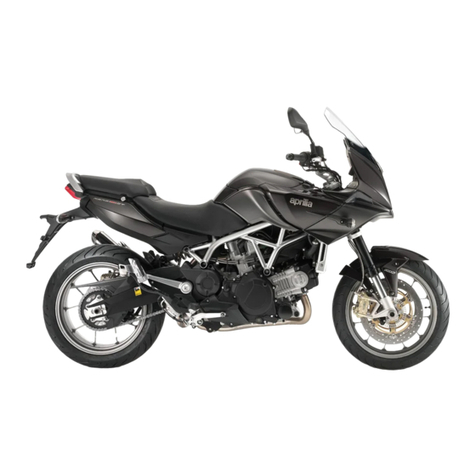
APRILIA
APRILIA MANA GT ABS - 2009 manual
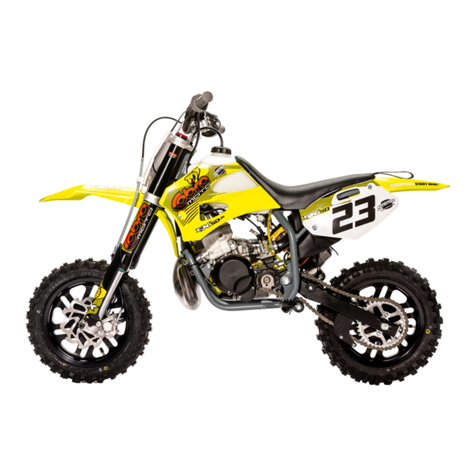
Cobra Moto
Cobra Moto CX50 owner's manual
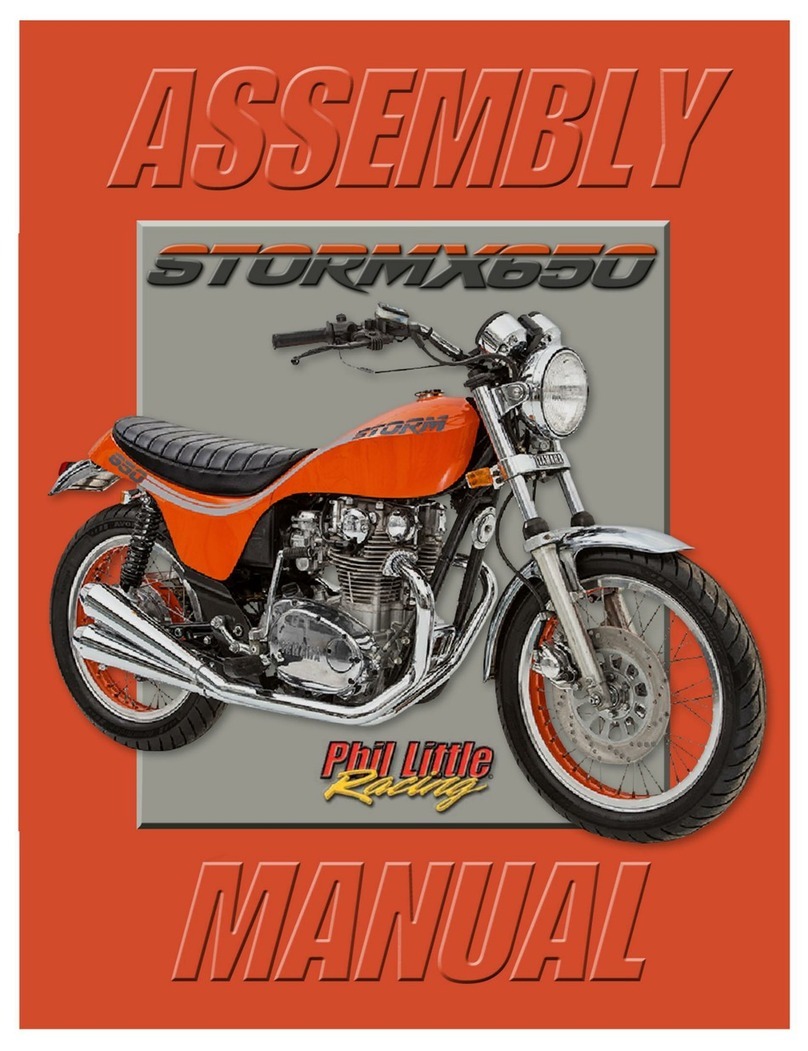
Yamaha
Yamaha X650 Assembly manual
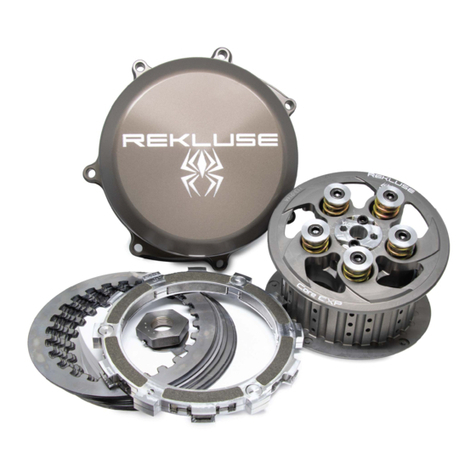
Rekluse
Rekluse Core EXP 3.0 TorqDrive Installation & user guide
